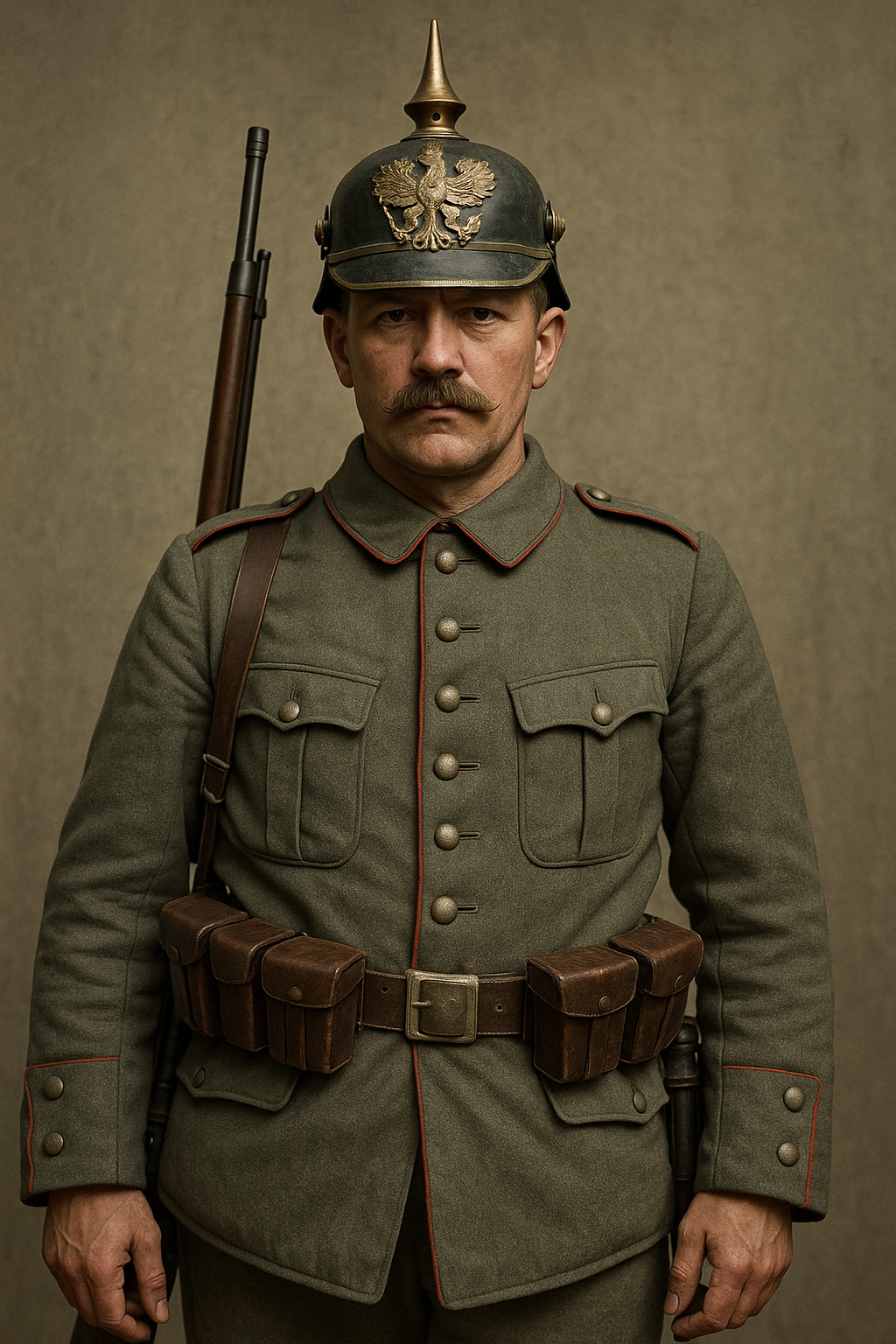
German Army WWI Uniform: History, Design & Legacy of Imperial Military Style
Published on Jun 30, 2025
German Army WWI Uniform: History of Imperial Military Style
Introduction: A Uniform That Shaped a War
The German Army uniform of World War I (1914–1918) wasn't just about looks—it embodied discipline, nationalism, and technological advancement. As the Great War broke out, Germany needed a uniform that could withstand trench warfare while projecting the might of the Kaiserreich (German Empire). Over time, the feldgrau (field gray) uniform became iconic, influencing military fashion and function worldwide.
1. Origins of the WWI German Uniform
At the dawn of World War I, the German military shifted from the vibrant pre-war uniforms of the 19th century to more practical and subdued designs. Gone were the bright blues and reds—efficiency and camouflage became the new priority.
The adoption of feldgrau in 1907 (General Order No. 14) marked a turning point. By the time WWI started, the German Empire had standardized this gray-green hue across its forces, offering a blend of camouflage and psychological unity.
2. Key Components of the WWI German Army Uniform
a. Pickelhaube Helmet
Arguably the most iconic piece of the uniform, the Pickelhaube (spiked helmet) was made of leather, sometimes covered with metal fittings. Early versions were polished and ornate, but trench warfare forced its evolution. By 1916, the Stahlhelm (steel helmet) replaced it, offering better protection.
b. Feldgrau Tunic (M1910, M1915)
The tunic (Bluse) went through several updates:
- M1910 Tunic: Had colored piping and tailored structure.
- M1915 Simplified Tunic: More utilitarian, with concealed buttons and minimal ornamentation.
These tunics typically featured:
- Stand-and-fall collar
- Pleated pockets
- Shoulder straps (often regimental-specific)
c. Trousers & Puttees
Worn with matching trousers, soldiers wrapped puttees (strips of cloth) around their lower legs for protection and ankle support.
d. Footwear
German troops wore jackboots—high leather boots—ideal for marching but less so for muddy trenches. Later, ankle boots with gaiters became more common.
e. Greatcoats and Field Gear
Heavy woolen mantels (greatcoats) were issued for cold weather. Soldiers carried a full set of leather field gear: ammo pouches, canteen, mess kit, and bread bag.
3. Rank and Regimental Insignia
While color was toned down for camouflage, rank distinctions remained visible:
- Shoulder straps and cuffs indicated rank and regiment.
- Collar patches were often red or green, contrasting the feldgrau.
- Officers sometimes had privately tailored uniforms with better fabric and finish.
4. Differences Between Enlisted Men and Officers
- Enlisted Men: Issued standard uniforms; less personal customization.
- Officers: Often wore higher-quality materials, private tailoring, and carried personal sidearms.
- Officer tunics had silver piping and sometimes shoulder cords instead of straps.
5. Materials and Manufacturing
The uniforms were primarily made from wool, providing warmth and durability. However, as the war dragged on and resources thinned, Germany substituted with inferior fabrics, leading to inconsistency in quality.
Uniform production was massive—millions were manufactured across the Empire, with variations based on region and available materials.
6. Evolution Throughout the War
WWI uniforms evolved rapidly:
- 1914: Formal, decorative touches still present.
- 1915–1916: More functional, drab, and simplified.
- 1917–1918: Efficiency over aesthetics, including Stahlhelm adoption, canvas gear, and factory-made tunics.
7. Reenactment, Collecting, and Legacy
Today, original WWI German uniforms are rare and highly collectible. Many reenactors and historians seek accurate reproductions for events, museums, or displays. At Paddelaters, we specialize in:
- Authentic reproduction WWI German uniforms
- Field gear and helmets
- Officer and enlisted rank variations
These uniforms remain popular among:
- Collectors
- Theatrical productions
- Historical educators
- Military history buffs
8. Why the German WWI Uniform Still Matters
The WWI German Army uniform isn’t just about historical fashion—it’s a reflection of early 20th-century military transformation:
- Birth of camouflage-focused design
- Use of industrial manufacturing in uniform production
- Cultural identity through military style
Its legacy influenced WWII German uniforms and even modern-day military gear. The feldgrau, the pickelhaube, and the stahlhelm all echo through modern military symbolism.
9. Buying Authentic Reproduction German WWI Uniforms
If you're looking to purchase a WWI German Army uniform, Paddelaters.com is your trusted source for:
- Historically accurate reproductions
- High-quality materials
- Worldwide shipping
- Options for both collectors and reenactors
We offer:
- M1910 and M1915 tunics
- Pickelhaube and Stahlhelm replicas
- Leather field gear and belts
- Full reenactment-ready kits
Every item is carefully crafted with attention to historical detail, making it perfect for WWI displays, living history events, or museum installations.
Conclusion
The German Army WWI uniform represents more than just fabric and leather—it's a story of innovation, identity, and transformation during one of the most significant conflicts in human history. Whether you’re drawn to its design, historical value, or legacy, understanding this uniform gives you deeper insight into the era that shaped the modern world.
At Paddelaters, we honor that legacy by bringing you accurate, durable, and authentic reproductions of these incredible pieces of history.
